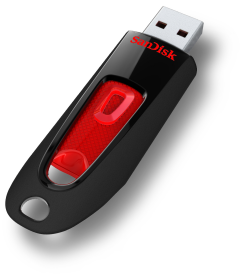

Model: SanDisk Ultra USB Flash Drive
Manufacturer: SanDisk
Provided By: SanDisk
SanDisk has been a leader in the storage industry for more than 20 years. Founded in 1988 by Dr. Eli Harari, the company has grown to become the world's largest supplier of flash memory data storage products. The company offers a wide range of products including memory cards, USB flash drives, SSDs and its popular line of Sansa music and video players.
At this year's Consumer Electronics Show (CES), SanDisk unveiled its Ultra USB flash drive. Available in 8GB, 16GB and 32GB capacities, this new drive sports an attractive slider design and is capable of transfer speeds of up to 15 MB/s. The Ultra also ships with SanDisk's SecureAccess software, which protects files against unauthorized access by creating an encrypted, password-protected folder or "vault" on the drive. To top it all off, the Ultra is compatible with Windows XP/Vista/7 as well as Mac OS X and is backed by a five-year warranty.
Packaging:
The SanDisk Ultra comes packaged in a cardboard blister pack. This type of packaging is not only more eco-friendly than the plastic clamshells that most USB flash drives come in, it can be opened by simply cutting along the dotted line.
Physical Features:
While not nearly as small as the Cruzer Blade, the SanDisk Ultra is still fairly compact. With the USB connector retracted, the drive measures about 57mm long, 21mm wide and 9mm thick. At this size, the SanDisk Ultra is barely noticeable when carried in a pocket or on a keychain.

The body of the SanDisk Ultra is constructed of a lightweight, black plastic. While the top has a glossy finish, the sides and bottom have a rougher, matte finish which makes it a little easier to hang onto the drive. The SanDisk Ultra also has a hole on the end so that it can be attached to your key ring.

The SanDisk Ultra's bright red USB connector is exposed using a unique sliding mechanism which can be manipulated with just your thumb. Underneath the sliding mechanism is an LED which pulses rapidly when data is being transferred and slows down when the drive is idle.
Installation:
As with most USB flash drives, the Ultra Backup was very easy to install. Those running Windows XP, Vista or 7 can simply plug the drive into any available USB port on their computer. If the computer is already turned on, plug and play will automatically detect the drive.
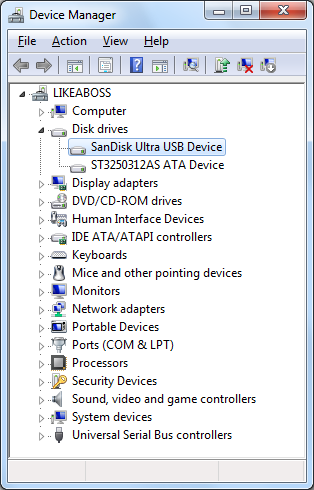
If installed correctly, the Ultra Backup should show up in the Device Manager. Under Windows 7, the drive is identified as a "SanDisk Ultra USB Device".
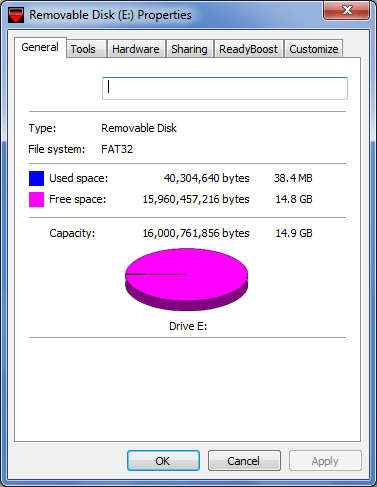
The Ultra Backup comes formatted with FAT32, giving the 16GB model about 14.9GB of usable space. Of that, about 38MB is taken up by the SecureAccess software that comes bundled with the drive.
Software:
The SanDisk Ultra is one of the first USB flash drives to ship with the company's new SecureAccess software. Available for both Windows and Mac, SecureAccess is a fast and easy way to protect sensitive files on any SanDisk USB flash drive. The software automatically secures files using 128-bit AES encryption and then stores them in a password-protected folder or “vault" on the drive.
Before you can protect files using SecureAccess, you will need to create your own vault. To begin, connect the SanDisk Ultra to your computer and double-click the RunSanDiskSecureAccess.exe file. When the program launches, select your preferred language and enter a personal password for the vault. The password must be at least 6 characters and contain both numeric and alphabet characters.

This screen also gives you the option to install SecureAccess Manager on your computer. While this isn't required, it will automatically launch SecureAccess when you plug in your drive.

Files and folders can be moved into your vault by dragging and dropping them onto the main screen or the vault icon. They can also be copied and pasted onto the main screen or added manually using the "Add Files" button.
SanDisk SecureAccess also includes support for YuuWaa's online backup service. To use this feature, create a YuuWaa account and select which folders and file types you want to backup. Once backed up, your files can be accessed from any computer using a web browser.
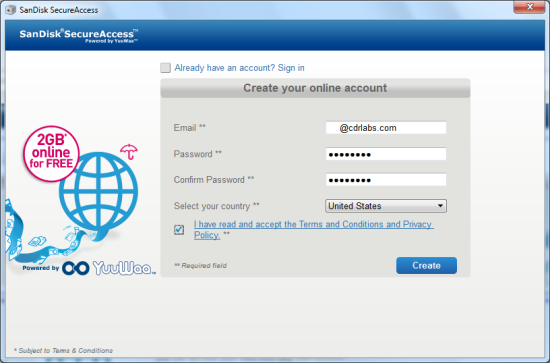
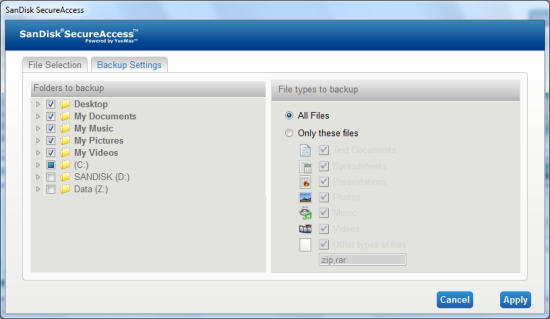
YuuWaa lets you store up to 2GB of data for free. If you need more, you can buy a yearly service plan which includes additional storage. Prices range from $11.99 for 11GB up to $169.99 for 200GB of storage.
The test system used in this review was an HP 8200 Elite. The computer came equipped with an Intel Core i5-2400 CPU, 4GB of DDR3 1333MHz memory, Seagate Barracuda 7200.12 ST3250312AS 250GB SATA 6 Gb/s hard drive, NVIDIA Quadro FX580 512MB PCIe graphics card and an Intel 82579-LM gigabit network card. For the operating system, I installed a fresh copy of Windows 7 Enterprise.
To test the performance of the SanDisk Ultra, I ran a series of benchmarks using CrystalDiskMark 3.0.1, HD Tach RW 3.0.4.0, ATTO Disk Benchmark 2.46 and SiSoftware Sandra Lite 2010.SP2. To get a feel for the "real world" performance, I also copied and pasted 500MB of random files and directories in Windows Explorer.
CrystalDiskMark 3.0:
First, I ran a few quick tests using CrystalDiskMark. This benchmark tool measures the performance of a storage device by testing its sequential read and write speeds as well as its random read and write speeds using blocks 512K and 4K in size.
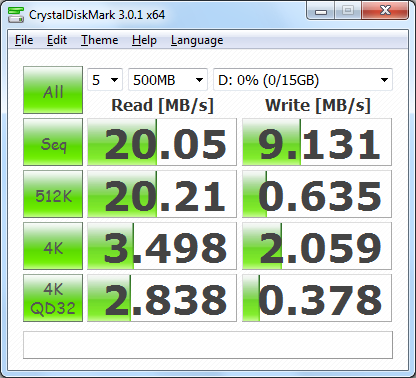
According to SanDisk, the Ultra features transfer speeds of up to 15 MB/s. Using CrystalDiskMark we can see that the drive is able to read at 20 MB/s and write at 9 MB/s.
HD Tach RW 3.0.4.0:
Next, I used HD Tach to test the SanDisk Ultra's read, write and burst speeds as well as its seek times and CPU usage.

The SanDisk Ultra's performance was hit and miss when tested with HD Tach. The drive had an average read speed of 31.7 MB/s but slowed to a mere 2.5 MB/s when writing. I did some research and found that while the Ultra is capable of writing at 10 MB/s, this only applies to the first 20 MB of the data transfer. After that, it appears that the writing speed drops to 2.5 MB/s.
ATTO Disk Benchmark 2.46:
I also used ATTO Disk Benchmark to test the Ultra's sequential read and write speeds. The test was run using blocks ranging in size from 0.5KB to 8192KB and the total length set to 256MB.

The performance here was very similar to what we saw with HD Tach. Looking at the screenshot above, you can see that the SanDisk Ultra was able to read at speeds as high as 31.6 MB/s. The drive also started out strong when writing but then dropped to 2.5 MB/s with blocks 64KB and larger.
SiSoft Sandra File System Benchmark:
While I am not a big fan of SiSoftware Sandra's optical drive benchmarks, it is a great tool if you want to test a system's performance quickly and easily. One of Sandra's more useful tests is the File System benchmark. This benchmark gives each drive an overall score, or "Drive Index," based on the results of its read and write tests.
| SanDisk Ultra | SanDisk Cruzer Blade |
SanDisk Ultra Backup |
Kingston DT Locker+ |
|
| Drive Index: | 16.00 MB/s | 15.87 MB/s | 17.60 MB/s | 18.55 MB/s |
| Buffered Read: | 19.00 MB/s | 19.53 MB/s | 20.48 MB/s | 21.10 MB/s |
| Sequential Read: | 18.75 MB/s | 19.00 MB/s | 20.00 MB/s | 22.23 MB/s |
| Random Read: | 18.58 MB/s | 19.00 MB/s | 20.00 MB/s | 22.00 MB/s |
| Buffered Write: | 4.88 MB/s | 7.23 MB/s | 895 MB/s | 2.30 MB/s |
| Sequential Write: | 8.22 MB/s | 5.00 MB/s | 11.26 MB/s | 6.00 MB/s |
| Random Write: | 1.00 MB/s | 1.00 MB/s | 2.30 MB/s | 1.70 MB/s |
SiSoftware Sandra Removable Storage/Flash Devices Benchmark:
Designed with removable storage and flash devices in mind, this benchmark tests a drive's read, write and delete performance using six different file sizes (512 Bytes, 32kB, 256kB, 2MB, 64MB and 256MB). The results are then given in both operations per minute and the corresponding net transfer rate in MB/second. This benchmark also computes an "Endurance Factor," representing the wear and life expectancy of flash devices.
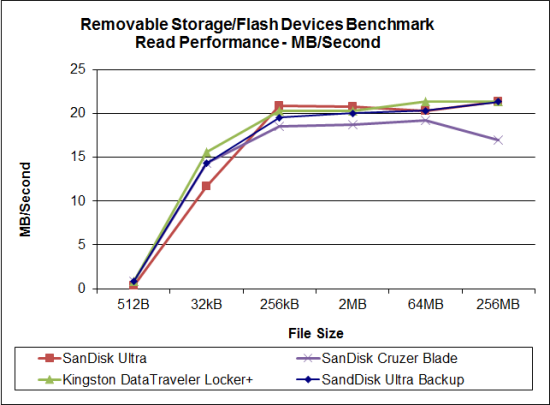
| SanDisk Ultra | SanDisk Cruzer Blade |
SanDisk Ultra Backup |
Kingston DT Locker+ |
|
| 512B Read: | 0.322 MB/s | 0.811 MB/s | 0.806 MB/s | 0.811 MB/s |
| 32kB Read: | 11.67 MB/s | 14.36 MB/s | 14.28 MB/s | 15.56 MB/s |
| 256kB Read: | 20.87 MB/s | 18.47 MB/s | 19.52 MB/s | 20.27 MB/s |
| 2MB Read: | 20.80 MB/s | 18.67 MB/s | 20.00 MB/s | 20.27 MB/s |
| 64MB Read: | 20.27 MB/s | 19.20 MB/s | 20.27 MB/s | 21.33 MB/s |
| 256MB Read: | 21.33 MB/s | 17.00 MB/s | 21.33 MB/s | 21.33 MB/s |
The SanDisk Ultra was a little slower than the other drives when reading 512B and 32kB files. Nevertheless, it performed very well when reading larger files, reaching a maximum speed of 21.33 MB/s.

| SanDisk Ultra | SanDisk Cruzer Blade |
SanDisk Ultra Backup |
Kingston DT Locker+ |
|
| 512B Write: | 0.030 MB/s | 0.033 MB/s | 0.045 MB/s | 0.014 MB/s |
| 32kB Write: | 1.84 MB/s | 0.325 MB/s | 1.25 MB/s | 0.86 MB/s |
| 256kB Write: | 4.27 MB/s | 4.00 MB/s | 5.57 MB/s | 3.00 MB/s |
| 2MB Write: | 6.77 MB/s | 2.00 MB/s | 3.37 MB/s | 2.77 MB/s |
| 64MB Write: | 8.53 MB/s | 4.27 MB/s | 9.60 MB/s | 5.33 MB/s |
| 256MB Write: | 8.53 MB/s | 4.27 MB/s | 8.53 MB/s | 4.27 MB/s |
The SanDisk Ultra also performed fairly well when writing. The drive reached a maximum speed of 8.53 MB/s and did not exhibit any of the slow downs we saw with HD Tach and ATTO.

| SanDisk Ultra | SanDisk Cruzer Blade |
SanDisk Ultra Backup |
Kingston DT Locker+ |
|
| Combined Index: | 98.12 | 78.77 | 80.48 | 58.10 |
| 512B Files Test: | 145.27 | 189.5 | 84.72 | 242.45 |
| 32kB Files Test: | 125.40 | 90.93 | 73.40 | 107.52 |
| 256kB Files Test: | 38.65 | 36.60 | 30.03 | 46.70 |
| 2MB Files Test: | 6.77 | 2.77 | 3.60 | 4.18 |
| 64MB Files Test: | 0.23 | 0.17 | 0.18 | 0.25 |
| 256MB Files Test: | 0.05 | 0.05 | 0.05 | 0.07 |
As I mentioned above, Sandra also expresses performance in operations per minute. To keep things simple, I've limited the results to the combined index and the total number of read/write/delete operations for each file size.
| SanDisk Cruzer Blade |
SanDisk Ultra Backup |
Kingston DT Locker+ |
SanDisk Cruzer Enterprise |
|
| Endurance Factor: | 1.10 | 64.30 | 2.20 | 8.60 |
The Endurance Factor represents the wear and life expectancy of a flash device. According to SiSoft, this number is computed by "dividing the average performance (normal condition, i.e. sequential write) to the lowest performance (high-stress condition, i.e. same block re-write)."
"Real World" Benchmark:
To test the "real world" performance of SanDisk's new flash drive, I copied and pasted 500 MB worth of randomly generated files and directories. All of the files are between 10 bytes and 32MB in size and no more than four directories deep.
| SanDisk Ultra | SanDisk Cruzer Blade |
SanDisk Ultra Backup |
Kingston DT Locker+ |
|
| Write: | 1:30 | 4:03 | 3:22 | 2:50 |
| Read: | 30 seconds | 32 seconds | 32 seconds | 31 seconds |
The SanDisk Ultra performed very well here, taking a minute and a half to write our test data and 30 seconds to read it back.
Final Thoughts:
The SanDisk Ultra is a great choice for a student or anyone else looking for a speedy and stylish USB flash drive to securely store and transfer their files. The drive is lightweight, well constructed and sports an attractive slider design. While not nearly as fast as some of the newer USB 3.0 flash drives, the Ultra performed relatively well for the most part, reading at speeds as high as 31 MB/s and writing at 9 MB/s. The drive also ships with SanDisk's new SecureAccess software. Along with online backup capabilities, SecureAccess protects your files against unauthorized access by storing them in an encrypted, password-protected "vault" on the drive.
Aside from the fact that you get only 2GB of online storage, the only real issue I have with the SanDisk Ultra is that it writes at its maximum speed only during the first 20MB of the data transfer. After that, the drive's write speed drops to a mere 2.5 MB/s. We saw this in a handful of our tests but thankfully, it seemed to have little, if any, effect on the Ultra's real world performance.
The SanDisk Ultra is available now in 8GB, 16GB and 32GB capacities. Suggested retail prices range from $44.99 to $109.99 depending on the size. However, the drive can be picked up for considerably less from Amazon or through some of the vendors on PriceGrabber.
Highs:
- Good performance for a USB 2.0 flash drive
- SecureAccess software protects files in encrypted, password-protected "vault"
- USB connector protected by sliding mechanism
- Compatible with Windows XP/Vista/7 and Mac OS X
- Nice looking, lightweight design
- Five year warranty
- Reasonably priced
Lows:
- 10 MB/s write speed only applies to the first 20 MB of the data transfer
- Includes only 2GB of online storage



